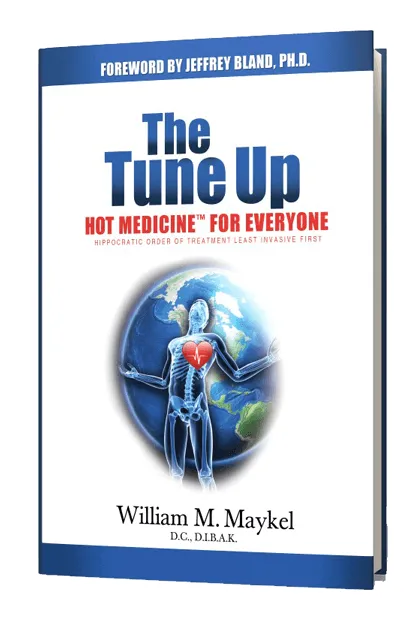The Answer to this Question Depends, to a Large Degree, on the Balance of Your Autonomic Nervous System.
This is without a doubt the most important reason to get a TUNE UP on a regular basis. The TUNE-UP is a head to toe examination for and treatment for correction of your body’s stress maladaptation patterns (MAPS). These are the functional changes that occur to our physiological/structural alignment as a response to stress and trauma. As the understanding of health and disease unfolds viewed through the lens of a systems-biology approach, one component that shines bright is the concept of balance. The hand of Mother Nature selects for balance or symmetry in all of her creation. It is the loss of balance or symmetry that lies at the heart of the mechanism of virtually all disease.
Let’s apply this understanding to the function of your nervous system. This system controls and coordinates a vast amount of data to enable your collection of 400 trillion cells to function together holographically, promoting your health and maintaining well-being. Your nervous system is estimated to be doing 1023 tasks each moment. This is a huge number called a septillion, which represents more planets than there are in 9 universes.
In order for our bodies to accomplish such a feat continuously, there exists an internal organization to the nervous system. We all know that it is very difficult to comprehend what you are reading if someone is talking to you at the same time. This is due to the fact that you only have 10 percent of your nervous system to work with consciously or volitionally at any moment. Ninety percent of your nervous system functions automatically, in what has been termed the autonomic nervous system (ANS), which operates with two parts or hands – the sympathetic nervous system (SNS) and the parasympathetic nervous system (PNS). The dynamic interplay back and forth of these nervous system components allows for allostasis. This is the homeodynamic ongoing response to stress of all kinds. This stems from the concept of homeostasis which is balanced physiology at the cellular level. It is the body’s way of remaining stable in a changing environment.
The sympathetic side, arising from your throat and chest is designed to work in quick spurts to keep you away from the “lions, tigers and bears” that life offers up at any moment. This is the “fight or flight” part of your nervous system. The vascular system responds by shunting blood from the skin and the gastrointestinal tract to the core muscles of motion. Your immune system initially stands on high alert. When “locked in” for a prolonged periods it becomes dysfunctional. This in turn makes you catabolic, requiring a large amount of energy just to hold you upright in a gravity field. Stress MAPS arise, expressing their subsequent symptoms.
On the other hand, is your PNS. This arises, as its name implies, on either end of the sympathetic nervous system (head and pelvis – see figures page 5). The PNS allows the basic functions we call life to take place. This includes sleeping, eating, breathing, digesting, assimilating, detoxifying, eliminating and reproducing. It is the rest and repair part of your nervous system. When fully functional, you are anabolic, with no energy required to hold you up in earth’s gravity field. Full smooth functional movement ensues. You are thus aging slowly and gracefully with no pain or disease.
The word “stress” did not become the most frequently googled word in physiology and medicine without a reason. The SNS helps us respond to stress, but, unfortunately do so in today’s technological world 24/7 instead of on an intermittent basis. For the majority of people today, the impact of the convergence of multiple chronic stressors (1) tips their body into a sympathetic dominant response mode. This imbalance makes them catabolic. My favorite analogy is that a person becomes like the defective Toyota Corollas that were recalled due to the accelerators sticking to the floor. In this state a person is aging quickly with amplified systemic degenerative changes.
One of the most common reasons this happens is the need to process an abundance of information. The two sides of our brain are called the temporal lobes. When we sleep at night their function is to cross associate the data from the previous day’s activity. The more data we are exposed to the faster the information jumps from one side to the other. This is associated with the rapid eye movements (REM) in the sleep states. One leading theory as to why we clench and brux our teeth at night is that the temporalis muscles tighten up to slow this REM process down. This slows down the speed of the neural processing by actually decreasing the blood supply to these brain areas. Failure to have optimal dental occlusion leads to a locking up of the joints (sutures) between your 22 cranial bones. (See list of other reasons (2). This impairs the out flow of the PNS, creating or contributing to dysfunction in any of the organs connected by this system. A cranial stress MAP puts the person instantly into an allostatic load.
The vagus nerve is your tenth cranial nerve (out of twelve) and derives its name from the latin word “wanderer.” This one nerve is actually a collection of nerve centers with a vast array of functions. It makes up the majority (75%) of your PNS. The vagal system controls everything from your mouth through the first half of your large intestine. This includes the following functions:
- Your ability to manufacture enough digestive enzymes to breakdown foods into their component parts. (3)
- Your ability to optimally absorb these nutrients into your body.
- Your ability to have a competent immune system, since 50% of your immune system lines your small intestine which creates 77% of your circulating antibodies. (4)
- Adequate detoxification of internal and external toxins. Your detoxification system is a bipartisan effort, performed, for the most part by your liver/gall bladder and small intestine. (4)
- The vagus complex serves to act as the “brake” for the heart. The healthier the vagal outflow, the more erratic the heartbeat is with breathing. This is known as heart rate variability. (5)
To avoid chronic complex disease, one must maintain a lifestyle that promotes health. Health is an actively created state. A clean, nutrient dense diet, devoid of refined sugars, flour, and genetically modified, ingredients (present in 90% of processed foods), antibiotic and pesticide laden foods, together with regular rest and exercise is essential.
Tuning up one’s body on a regular basis to maintain an anabolic state is a key preventive medical concept. Just as homeostasis is the process of balanced physiology at the cellular level, allostasis is the balance of the body’s multiple functions in response to stress. When pushed out of balance the term used is allostatic load. Physical “wear and tear” now occurring degenerating your body. Regular tune-ups promote allostasis. Remember, health is an actively created state. Just do it!
Footnotes:
- We currently are exposed to background microwave radiation from the cell phone industry which is one trillion fold normal; every square centimeter of the planet is impregnated with over one thousand cancer causing chemicals; all processed foods contain the pesticide roundup built into them.
-
There are seven major reasons that contribute to cranial stress MAPS:
a. Hitting your head, or walking into a pole or a tree.
b. Invasive dental work or maloocculsion.
c. Accidents even at 3–5 mph with no car damage.
d. Decreased digestive enzyme production.
e. Systemic infection – i.e., flu, infection, (sinus, kidney, bladder, lung, etc.)
f. Electromagnetic field stress, e.g., electric blankets, WIFI, cellphone use, car seat heaters.
g. Inadequate intake of the stress mineral magnesium. - This represents a huge misunderstanding in medicine today with 14 billion dollars a year spent on drugs to decrease stomach acid production. In actuality, only one person in one million has a gastroma (known as the Zollinger-Ellison Syndrome) that produces too much acid. The real underlying cause is various stressors diminishing stomach acid production with not enough to cause the pyloric sphincter at the far end of the stomach to open. This causes the small amount of acid that is produced along with the undigested food to reflux. This is exacerbated by a hiatal hernia, which is a strain of the diaphragm. This occurs every time a person develops a pelvic-spinal stress MAP with a strained pelvis. The psoas muscles contract to stabilize the sacroiliac joints and in so doing fixate the diaphragm causing the stomach to ride up through the opening for the esophagus. The lower esophageal sphincter is no longer reinforced by the diaphragm, allowing reflux.
- The small intestine function is now being proposed to be called the first brain instead of the second brain. New understanding is that it coordinates the nervous, endocrine and immune systems with dysfunction linked to neurological, inflammatory, circulatory, endocrine and autoimmune disease.
- Chiropractic adjustments have been shown to increase heart rate variability. This increase is correlated with a decrease in all causes of mortality.
1/30/14








